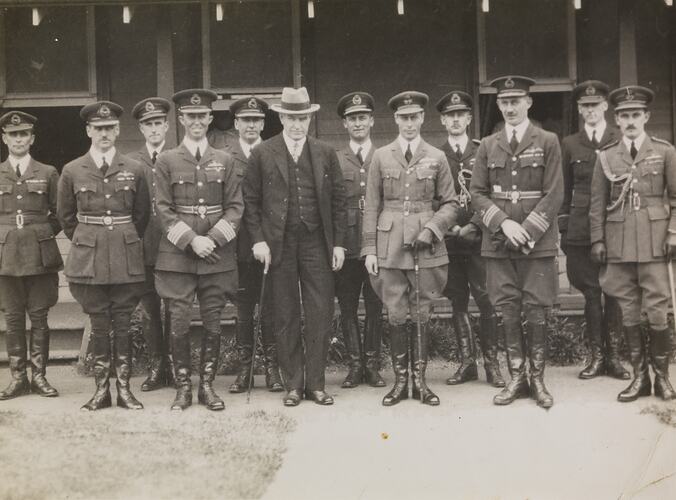Reserve forces in the Royal Australian Air Force (RAAF) were established on 14 November 1921, well after those of the other two Services. By early the following year, four ex-World War I squadrons had been re-formed, comprising one third Permanent Air Force members and two-thirds Citizen Air Force personnel. The siting of the RAAF's first two bases (Point Cook in Victoria and Richmond in New South Wales) was influenced strongly by the need for the Citizen Air Force to be accessible to personnel in Melbourne and Sydney.
The deteriorating political international situation in the mid 1930s promoted the expansion of the RAAF and the creation of more squadrons. No. 21 Squadron was formed on 20 April 1936, with the specific aim to provide an air defence capability for Melbourne. RAAF squadrons comprised a cadre of Permanent aircrew in one flight and two other flights made up of Citizen Force personnel. The then Governor of Victoria, Lord Huntingfield, was appointed Honorary Air Commodore, and gave permission for the horn and wings of his own coat of arms to be used in the Squadron's crest. He suggested the Squadron motto 'Coronat Victoria Fortes' (Victory Crowns the Brave), which appropriately contains 21 letters in both English and Latin.
When World War II broke out the RAAF comprised 3,000 Permanent Air Force members, 500 Citizen Air Force personnel and 150 officers on the Reserve List. 21SQN flew its first operational mission in December 1939, escorting a shipping convoy with its newer Anson aircraft. From this vital defensive patrolling Australia's seas, the Squadron became instrumental in defending and securing the south-west Pacific theatre of operations during World War II. In August 1940 the Squadron was deployed to Singapore and re-equipped with Wirraways and Brewster Buffalo fighters. The Squadron suffered heavily from Japanese air attacks in Malaya. It returned to Australia in early 1942 to be reformed. By the end of the War the Squadron had won battle honours for campaigns conducted in Malaya, New Guinea, Markham Valley, Morotai and Borneo.
After the war Citizen Air Force squadrons were re-formed as fighter units at locations close to their affiliated cities, including Melbourne and Sydney, and resumed their pre-war role of providing flying training for Citizen Air Force personnel. Between 1948 and 1960, 21SQN operated as a fighter unit flying Wirraway, Mustang and Vampire aircraft. Following Prime Minister Menzies' 'call to arms' in 1950, the Air Board approved an extension of Citizen Air Force squadrons. This revival called for an Active Reserve of 10,000 personnel, but by 1953 the prospect of renewed global hostilities had receded, defence spending was curtailed and the Citizen Air Force receded to only 1,620 personnel. By contrast, the RAAF General Reserve (a list of retired personnel with no service obligation execpt in a defence emergency) kept growing. As with all Reserve units in Australia, 21SQN ceased flying operations in 1960 and became an auxiliary unit supporting Air Force operations, primarily aircraft maintenance.
The role of the Citizen Air Force was further reduced in ensuing decades.
Today, 21SQN has members in all musterings and specialisations supporting Air Force and ADF operations in Melbourne and throughout Australia.
The Victorian Governor is still Honorary Air Commodore of the City of Melbourne Squadron.
References:
Royal Australian Air Force Reserve website http://www.defencereservessupport.gov.au/about/history/
Air Force News http://www.defence.gov.au/news/raafnews/editions/4403/story09.htm
More Information
-
Keywords
-
Localities
-
Authors
-
Article types
